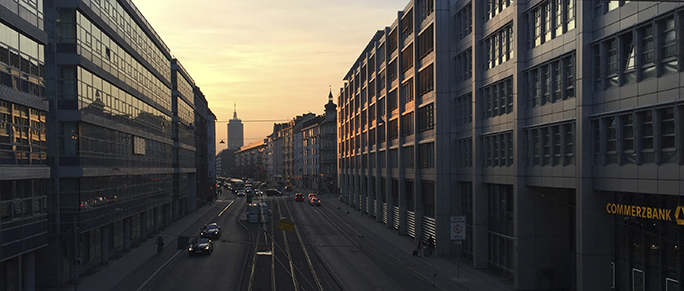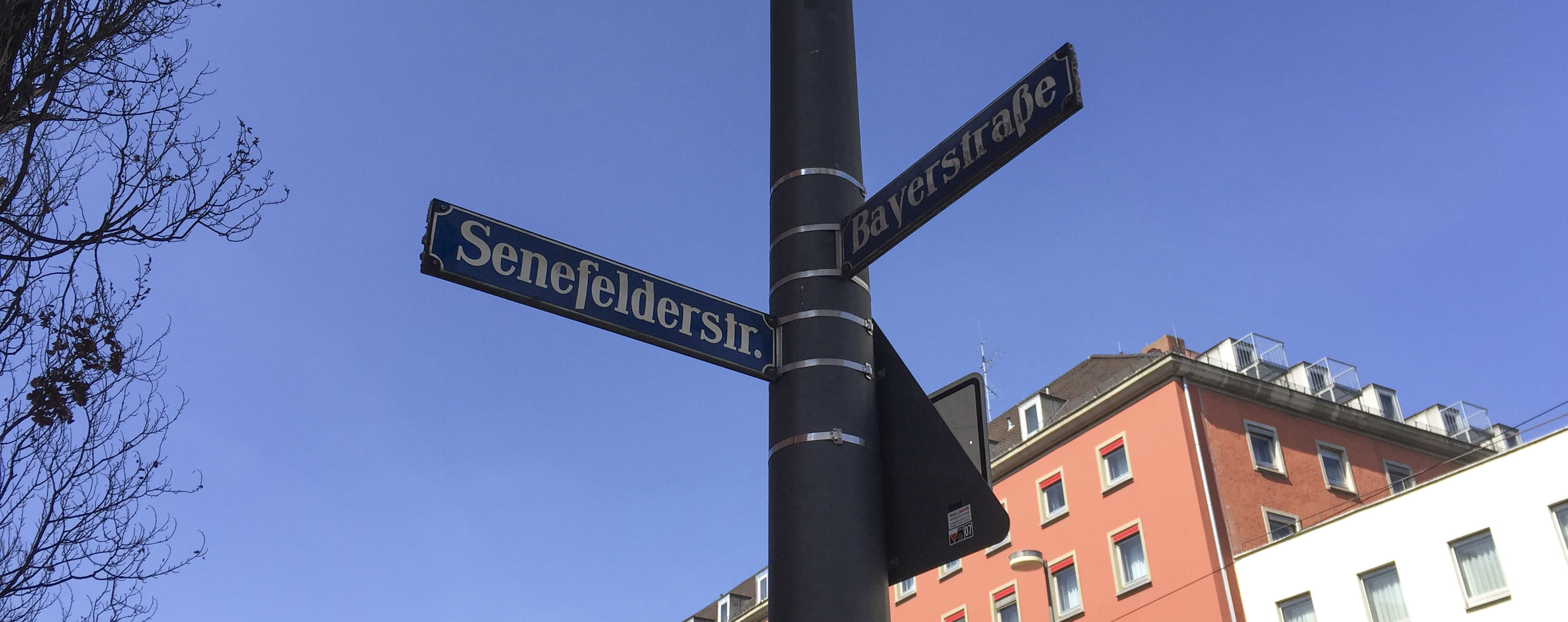I walked down Bayerstrasse yesterday morning, heading east from our apartment near the Hauptbahnhof, then turned right on Senefelderstraße. I made a point of doing this because I was on my way to the big Calumet camera store in Munich (Calumet has gone out of business in the U.S. but is prospering in Germany).
This is the view west on Bayerstraße in Munich. Bayerstraße is named for Friedrich Bayer, the co-inventor of aspirin. I get a headache just thinking about it. This is a block from our apartment in Munich.
My reason for choosing Senefelderstraße instead of the street before it, which would have been a bit shorter, is that Aloys Johann Nepomuk Franz Senefelder is the inventor of lithography, and I have never walked his street before. I took this street to honor him.
I’ve found Senefelderstraße, and have learned that there is also a Gutenbergstraße near the Nymphenburg Castle, and even a Mergenthalerstraße a little further out near the Wurm River. I will go walk those streets and write nostalgically about their namesakes when I get a chance.
Senefelderstraße is not a grand street by any measure. It’s populated by travel agencies and a few low-end hotels. There are a couple of vegetable stalls and a neighborhood market. I walked the length of it.
The corner of Senefelderstraße and Bayerstraße in Munich. This is in the vicinity of the central train station.
Herr Senefelder discovered that an image could be made on a smooth, polished limestone surface using regular drawing tools – pens, pencils and such, then that image could be inked, and the stone cleaned with water to make a reproducible image on the stone. A piece of paper, some pressure, and (as they say in German) voilà! You have printing.
The stone quarry that Senefelder preferred is called Solnhofen Quarry. His limestone slabs were quarried in Solnhofen and nearby Eichstätt, about 100 km. north of Munich. That particular stone was quarried for lithographic stones (and other artistic purposes) for centuries. Today it is treated as an archaeological site because the quarry is rich with fossils. Here is a quote from Fosseil.net, a web site devoted to the archaeological importance of these limestone quarries:
Solnhofen is known for the 10 Archeopteryx prehistoric birds that have been found here. The first feather was found in 1860, and the first Archeopteryx was found in 1861. In the Jura Museum in Eichstätt and the Bürgermeister Müller museum in Solnhofen you can see the original fossil birds.
The Solnhofen limestone was named after the village of Solnhofen in the Altmühltal valley. This limestone is exposed in a large area around the village. Many villages in the area have their own commercial quarries. The limestone is used for building material.
The limestone from the upper Jurassic period occurs in the area between Weißenburg, Regensburg, Nürnberg and Ingolstadt.
In the Altmühltal there are several museums, where you can learn about the geology and see the fossils found in this area. More than 800 species of plants and animals have been found in the Plattenkalk from the Jurassic period.
It’s fun to be in the heart of Germany, in the places where the seeds of printing were planted.
A field trip!
I’ll be taking my Advanced Typography students on a field trip to Mainz, to the Gutenberg Museum, on the 25th of April. There we will see two of Germany’s 12 Gutenberg Bibles, (known as Hubay 8 and 9). We will also receive a lecture by that museum’s specialist on Herr Johannes Gensfleisch (probably his real name).
I’m enjoying the opportunity to go straight to the source on these typographic and printing topics. And you will read about it here in the Blognosticator (German edition) as I make these treks.




Haven’t heard “Calumet” in a few years. I handled my first dSLR at Calumet in Escondido, CA and later bought my first Canon 10D there. I never thought I would be comfortable buying big ticket items online but now B&H supplies almost all my photographic needs. Progress has no patience for tradition.